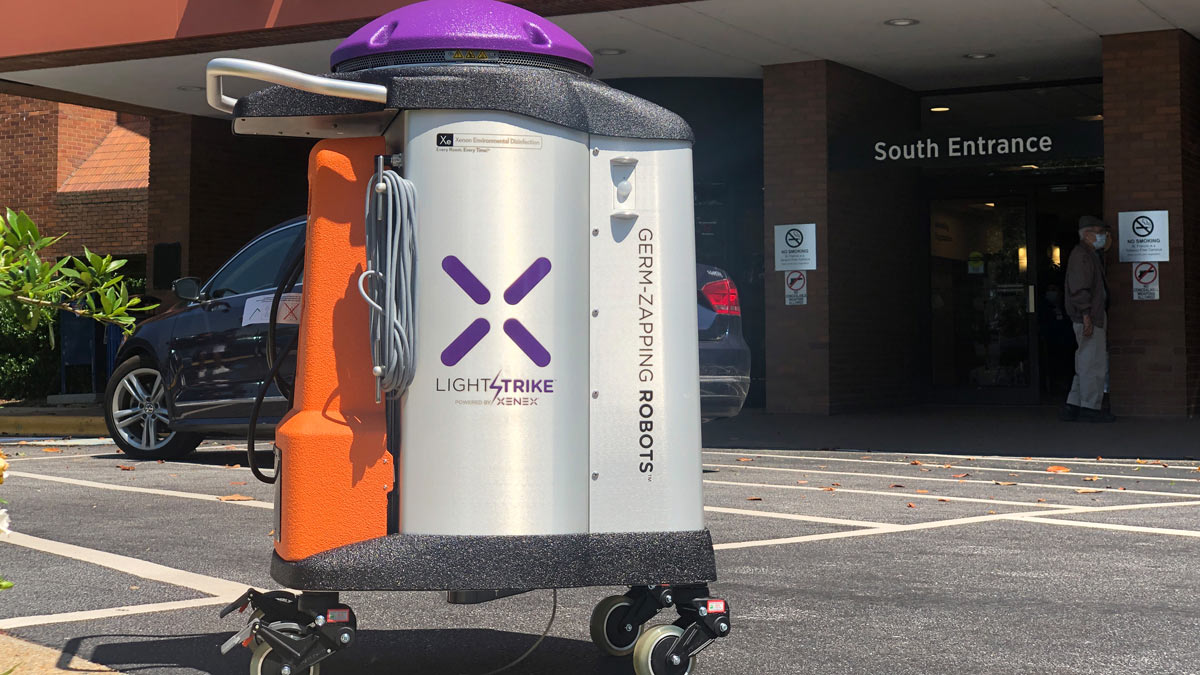Responding to the COVID-19 pandemic, hospitals on the front lines have been adopting new cleaning protocols and applying innovative technology to prevent the spread of infection and minimize the risk for patients and staff members.
From identifying and isolating COVID-19 patients and disinfecting rooms and personal protective equipment to enacting new visitation guidelines – hospitals are implementing numerous measures to stem the virus’ advance and provide a safe environment for all.
Shannon McCowan, chief operating officer of Bon Secours St. Francis-Greenville, said they set up an incident command during the second week of March. The command is a multidisciplinary team comprised of members of the executive team, along with frontline workers including physicians, nurses, physicians’ staff, and Emergency Department, pharmacy and supply staff, among others. A red team and a blue team rotate every week to avoid fatigue.
COVID-19 containment measures adopted by Bon Secours include requiring all staff to wear masks; a more recent mandate requiring any staff interacting with patients to don eye shields; and a visitation rule limiting one visitor per patient per day. The visitation regulation applies to elective surgeries and rehab. During the height of the pandemic, visitors were prohibited, and even now visitors must submit to a temperature check and COVID-19 screening at all entrances.
Visiting COVID-19 patients generally isn’t permitted, aside from end-of-life situations where special accommodations are made for family.
Patients undergoing elective surgeries are administered a COVID-19 test prior to the procedure and must test negative before surgery is approved. Confirmed or suspected coronavirus cases are placed in isolation rooms in a unit separate from other patients to avoid cross-contamination. McCowan noted that the benefit of Bon Secours having two hospitals in Greenville – St. Francis downtown and St. Francis Eastside – is that they are able to move cancer patients from the downtown oncology unit to the eastside, where there are no COVID-19 patients.
Eastside also houses the Neonatal Intensive Care Unit. For bonding purposes, the NICU makes an exception to the one visitor rule and allows both parents in, McCowan explained.
The hospitals have also employed new technology in infection control. In a fortuitous move, Bon Secours ordered a device just before the pandemic hit called a Xenex LightStrike Germ-Zapping Robot that uses high-intensity ultraviolet light to kill microbes such as viruses and bacteria. The robot disinfects rooms following the discharge of any confirmed or suspected COVID-19 patient, a process that typically takes 10 to 15 minutes.
“This gives us another level of precaution,” McCowan asserted.
Roper St. Francis Healthcare’s hospitals throughout the Lowcountry use UV light technology to decontaminate personal protective equipment, specifically N95 masks, for reuse.
Susan Scheeler, RSFH’s environmental safety manager, explained that when UV-C light is applied to a mask, it alters the DNA of viruses such as influenza and the novel coronavirus so that it is no longer an active contaminant.
The masks can go through anywhere from three to five UV-C cleaning cycles, depending on different user-dependent factors, including wear and tear, Scheeler stated. However, Roper St. Francis never allows a mask to go beyond five cleaning cycles.
“PPE can be reused when it’s done safely,” Scheeler commented.
The UV-C light sanitizing technology RSFH uses is based on an investigative study from the University of Nebraska Medical Center, where research determined that three to five cleaning cycles was the safe and effective range for reusing N95 masks. Roper adapted the UN Medical Center’s cleaning protocol, with some minor changes.
The hospital area where N95 masks are disinfected was previously used as a media studio for filming commercials, according to RSFH Media Relations Manager Robert Briggs. Amid the pandemic, it has been converted into a decontamination room with aluminum foil-draped walls where masks are hung on wire racks and blasted with UV-C rays.
Bon Secours works with a vendor that cleans and returns its N95 masks, but it utilizes UV boxes resembling small bread boxes to disinfect items such as stethoscopes and cellphones used in patient rooms, said McCowan.
Jimmy Wilkerson, RSFH’s environmental services manager, detailed the cleaning protocol that is followed to disinfect patient rooms and curb the spread of COVID-19.
After a patient is discharged, they wait an hour to begin cleaning, which allows time for the air to circulate. Next, they sterilize the entire room with bleach, a procedure that abides by recommended Centers for Disease Control and Prevention guidelines. Environmental services staff wear the proper personal protective equipment, including masks, gowns and gloves, throughout the cleaning process.
In high-traffic public spaces such as elevators and in common areas with furniture, they first perform a standard cleaning and then use a decontamination method called electrostatic spraying, which can further help sanitize surfaces and reduce COVID-19’s spread, said Wilkerson.
Additionally, in Roper’s COVID-19 unit, patients are placed in negative pressure rooms, which prevent contaminated air within from flowing into the hallway.
Environmental services also coordinates daily with RSFH’s infection prevention team, which monitors the latest CDC guidelines and provides the division with frequent updates that continue to evolve along with knowledge about COVID-19.
And although they are cleaning N95 masks for reuse, Wilkerson added that while there have been personal protective equipment shortages in various hospitals throughout the country, Roper’s stockpile was never in question, thanks to a proactive approach in maintaining an adequate supply.
“From day one, we never ran short of anything,” stated Wilkerson.
Chris Hawkins, a salesman and manufacturer’s rep in the Upstate who sells cleaning products to medical offices and health care facilities said, “There are products out there such as ClearSpace, an EPA and FDA-registered surface treatment that kills viruses and bacteria and prevents recontamination for up to 90 days, and Atmos-Clear, a portable sanitizing device that blasts the air with UV-C rays and sterilizes it, that can be used as well.”
He said you would most often see Atmos-Clear used in high traffic areas such as the lobby of a waiting room or an administration area. ClearSpace can be sprayed and applied to treat chairs, tables, fabric, glass and many other surfaces.
Despite all these preventive measures, many people are still reluctant to enter hospitals.
McCowan observed that Bon Secours has seen a significant number of people delay emergency room visits, elective surgeries and treatment for chronic conditions such as diabetes and heart disease, whether due to concerns over contracting COVID-19 in the hospital, fear of being tested for it or anxiety that a case spike will preclude visits from family members.
“A lot of people are waiting when they can, but, eventually, it becomes more critical,” she cautioned.
Staff are encouraging patients to address health issues in a timely manner and recognize that the hospital is following all recommended CDC guidelines to protect against COVID-19.
“From my perspective, I would feel much safer at the hospital than at the grocery store,” proclaimed McCowan.
By Colin McCandless







